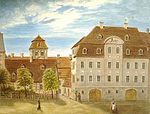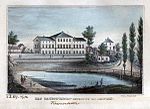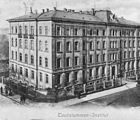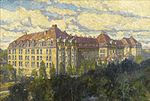Samuel Heinicke School (Leipzig)
| Saxon State School for the Hearing Impaired, Samuel Heinicke Support Center |
|
|---|---|

|
|
| The middle part of the school | |
| type of school | Special school for the hearing impaired |
| founding | 1778 |
| address |
Karl-Siegismund-Strasse 2 |
| place | Leipzig |
| country | Saxony |
| Country | Germany |
| Coordinates | 51 ° 19 '41 " N , 12 ° 23' 53" E |
| carrier | Free State of Saxony |
| Website | www.landesschule-fuer-hoergeschaedigte.sachsen.de |
The Samuel Heinicke School in Leipzig (official name Sächsische Landesschule for the hearing impaired, support center Samuel Heinicke ) is a special school for the hearing impaired. Founded in 1778 by Samuel Heinicke and operated continuously at different locations, it is the oldest state school for the deaf in Germany.
The school
The school is an educational institution for hearing-impaired children and young people. It comprises the primary school level with an extension of the primary school period by one year, the secondary school level and a course to promote learning. The following qualifications are possible: secondary school leaving certificate , qualifying secondary school leaving certificate , secondary school leaving certificate and the qualification “practical, complex performance”. In 2016 the school taught around 180 children.
Because of its supraregional importance, the facility has been sponsored by the Free State of Saxony since 1995 , which finances the school services, while extracurricular services such as all-day care and transport are provided by the local social welfare provider. The stay at home, which is possible until 2016, expires in the 2016/2017 school year.
In addition to the school for the hearing impaired, the facility offers other services. In the special needs day care center , hearing-impaired children are looked after from the age of two until they start school. In outpatient and mobile early intervention , the parents are advised and instructed, special educational diagnostics are carried out, the weekly curative educational support for listening and interdisciplinary cooperation with therapists, doctors and day-care centers take place. In the Cochlear Implant Center , patients who have had a cochlear implant are trained in hearing-directed language acquisition in collaboration with doctors, therapists, technicians and other supervisory institutions. The public library for the hearing and speech impaired is the most extensive collection point in the field of hearing and speech impaired in the German-speaking area
The building
The Samuel Heinicke School at Karl-Siegismund-Straße 2 in the Reudnitz district of Leipzig is a four-story building complex with a length of 163 meters. At both ends of the 12.5 m wide longitudinal wing, reinforced like a tower, there are 43 m long side wings with three bay windows facing the street. The entrance area, which is framed by two two-story square buildings, is located in the projecting 21 m wide central section with a flat roof.
Two groups of figures by the sculptor August Strohrigl over two meters high are found above the portal, a woman with a child on the left as "protective love" and on the right a man with a child as "educational care" and directly above the door a circular relief with a pelican, who feeds two boys with his blood. Four vases and eight fairy-tale figures with children's motifs by the sculptor Hans Zeißig (1863–1944) are positioned in niches on the second floor of the longitudinal front.
The classrooms are equipped with modern teaching and learning technology. Gym and therapy pool are available. Behind the building there is a 2.5 hectare park-like area with a sports and playground. To the south, next to the school, there is a memorial from 1824 for the sponsor of the school Luise Carl (1762–1815).
history
Samuel Heinicke (1727–1790) began teaching deaf students in the 1770s as a cantor and schoolmaster in Eppendorf near Hamburg . From 1777 he worked exclusively as a deaf and dumb teacher. In 1778 he reached by a request to the Saxon Elector Friedrich August III. to open the “Chursächsisches Institut for the dumb and other people with language disabilities” in Leipzig. The 51-year-old then moved to Leipzig with his second wife Anna (1757-1840) , who was 30 years younger than him, and nine students and opened his school in the “Weißes Roß” house on Roßplatz , which from 1782 was legally subordinate to the University of Leipzig . As in the Weißen Roß, private apartments were rented when the school moved because of the increasing number of pupils: in 1782 in Klostergasse, in 1785 in the Neuer Kirchhof at the Matthäi Church, in 1791 in the Neue Strasse in front of the Hallesches Pförtchen and in 1814 at the Thomaspförtchen. It was only through a generous bequest of 40,000 thalers from Luise Carl that the school was able to move into its first own building in Klitzschergasse (today Dimitroffstrasse) in 1822. Now there were 38 students.
When Samuel Heinicke died in 1790, his widow took over the management of the school. This made her the first woman in Germany to become the director of a school for the deaf. In 1828, on the 50th anniversary of the school, she was honored with a diamond ring from the Saxon King for her services and applied for her retirement in the same year at the age of 71 after 38 years as a director. Her successor was Carl Gottlob Reich (1782-1852) , who had been employed as a teacher since 1810 . One year before her death, in 1839, she was able to see the laying of the foundation stone for the first urban new building for the deaf-mute institute on the Kanonenteich in front of the Windmühlentor (roughly here today, Liebigstrasse University Eye Clinic). Gotthelf August Eichler (son-in-law of Carl Gottlob Reich) managed the facility from 1852 to 1896 .
After a few years there was already a lack of space and the building was extended. In 1880, for the same reason, a new building was moved into on Talstrasse for 100 students. As early as 1909, the planning for a new building began under the director Georg Wilhelm Schumann (1861–1924) appointed in the same year. In 1910, the site on Karl-Siegismund-Strasse was acquired, the groundbreaking ceremony took place on June 13, 1913, and the building, which is still in use today, was inaugurated as the Royal Institute for the Deaf and Mute in Leipzig on September 7, 1915 in the presence of the Saxon King . The new school was designed for a maximum of 320 students. In the main building there were classrooms for 32 classes of 10–12 students each, in the transverse wings the living rooms and large communal bedrooms for 280 students, divided into five living groups. A festival hall and a gym as well as other special classrooms and supply rooms were available.
During the Second World War , the building was used as a hospital from July 1941 . It was badly damaged in the bombing raid on Leipzig on December 4, 1943 . After the first repair work by the teachers and after the pupils had returned from the storage facilities, the first lessons could be resumed in August 1945, two months before regular school operations in Leipzig. In 1953 the school was given the name Samuel Heinicke School in memory of its founder. After the political change, the building and the outdoor facilities were renovated and modernized by the Free State of Saxony.
literature
- Horst Riedel: Stadtlexikon Leipzig from A to Z . 1st edition. PRO LEIPZIG, Leipzig 2005, ISBN 3-936508-03-8 , pp. 229 .
Web links
- Saxon State School for the Hearing Impaired Leipzig. In: school website. Retrieved May 30, 2016 .
- Anna Catharina Elisabeth Heinicke, b. Kludt. In: Website City of Leipzig. Retrieved May 30, 2016 .
Individual evidence
- ↑ www.sachsen.schule
- ↑ a b Information from the school
- ^ Profile of a special library. Retrieved June 3, 2016 .
- ↑ The new school. In: Exhibition 100 years of school buildings. Retrieved May 30, 2016 .








